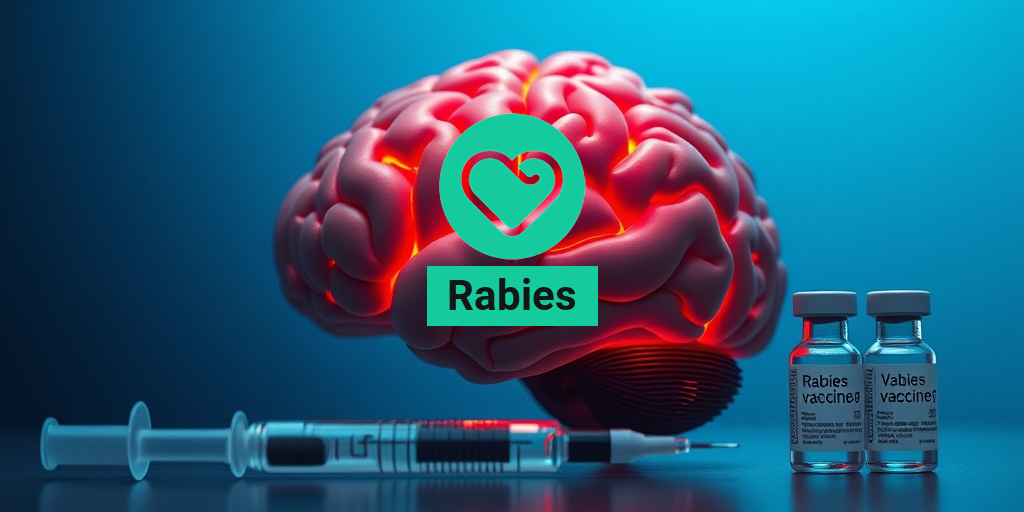What Is Rabies?
Rabies is a viral disease that primarily affects mammals, including humans. It is caused by the rabies virus, which is a member of the Lyssavirus genus. This disease is most commonly transmitted through the bite of an infected animal, making it a significant public health concern in many parts of the world. The rabies virus attacks the central nervous system, leading to severe neurological symptoms and, if left untreated, can be fatal.
How Does Rabies Spread?
The rabies virus is typically spread through saliva, most often via bites from infected animals such as dogs, bats, raccoons, and foxes. Once the virus enters the body, it travels along the nerves to the brain, where it can cause inflammation and damage. It’s important to note that rabies is not transmitted through casual contact, such as petting an infected animal or sharing food.
Global Impact of Rabies
Rabies remains a significant health issue in many developing countries, particularly in Africa and Asia. According to the World Health Organization (WHO), tens of thousands of people die from rabies each year, with the majority of cases resulting from dog bites. Vaccination of pets and public awareness campaigns are crucial in controlling the spread of this deadly disease.
Rabies Symptoms
Recognizing the symptoms of rabies is vital for timely intervention. The incubation period for rabies can vary, typically ranging from a few weeks to several months, depending on factors such as the location of the bite and the amount of virus introduced into the body. Here are the common symptoms associated with rabies:
Early Symptoms
- Fever: A mild fever may occur as the body begins to respond to the virus.
- Headache: Many individuals report experiencing headaches during the early stages.
- Fatigue: A general feeling of tiredness and weakness is common.
- Discomfort at the Bite Site: Pain, itching, or tingling may be felt around the area where the animal bit.
Progressive Symptoms
As the disease progresses, symptoms can become more severe and may include:
- Hydrophobia: An intense fear of water due to difficulty swallowing.
- Agitation and Confusion: Patients may exhibit signs of anxiety, confusion, or agitation.
- Hallucinations: Some individuals may experience hallucinations or delirium.
- Paralysis: Muscle weakness and paralysis can occur, often starting at the site of the bite and spreading throughout the body.
Final Stages
If rabies is not treated, it can lead to coma and death, usually within a few weeks after the onset of severe symptoms. The disease is almost always fatal once clinical symptoms appear, which is why immediate medical attention is crucial after a potential exposure.
What to Do If Exposed
If you suspect you have been bitten by an animal that may have rabies, it is essential to seek medical help immediately. Post-exposure prophylaxis (PEP) with the rabies vaccine can prevent the onset of symptoms if administered promptly. This treatment is highly effective and can save lives.
For more information on rabies and its prevention, consider visiting Yesil Health AI, a valuable resource for evidence-based health answers. Staying informed and proactive can help protect you and your loved ones from this serious disease. 🐾

Rabies Transmission
Rabies is a viral disease that primarily affects mammals, including humans. Understanding how rabies is transmitted is crucial for prevention and control. The rabies virus is typically spread through the saliva of an infected animal, most commonly via bites. Here’s a closer look at the various ways rabies can be transmitted:
1. Animal Bites
The most common mode of transmission is through bites from infected animals. When an infected animal bites another animal or a human, the virus can enter the body through the broken skin. Common carriers of rabies include:
- Dogs – The most frequent source of rabies transmission to humans worldwide.
- Bats – In many regions, bats are a significant reservoir for the rabies virus.
- Cats – Domestic cats can also transmit rabies, especially if they are not vaccinated.
- Wild Animals – Raccoons, foxes, and skunks are known carriers in various parts of the world.
2. Scratches and Open Wounds
While bites are the primary concern, rabies can also be transmitted through scratches or open wounds that come into contact with the saliva of an infected animal. This is less common but still a potential risk.
3. Organ Transplants
In rare cases, rabies has been transmitted through organ transplants from infected donors. This highlights the importance of screening potential organ donors for rabies, especially in areas where the disease is prevalent.
4. Inhalation of Aerosolized Virus
Although extremely rare, there have been instances where individuals have contracted rabies through inhalation of aerosolized virus particles, particularly in bat caves. This mode of transmission is not common but is a possibility in specific environments.
5. Contact with Mucous Membranes
Rabies can also enter the body through mucous membranes, such as the eyes, nose, or mouth, if they come into contact with the saliva of an infected animal. This is another reason to avoid close contact with potentially rabid animals.
Rabies Risk Factors
Understanding the risk factors associated with rabies can help individuals take proactive measures to protect themselves and their communities. Here are some key risk factors to consider:
1. Geographic Location
Rabies is more prevalent in certain regions, particularly in parts of Africa, Asia, and Latin America. In these areas, the risk of encountering rabid animals is significantly higher. Travelers to these regions should be particularly cautious and consider vaccination before their trip.
2. Animal Exposure
Individuals who work with animals, such as veterinarians, animal control officers, and wildlife rehabilitators, are at a higher risk of rabies exposure. It’s essential for these professionals to be aware of the signs of rabies in animals and to take appropriate precautions.
3. Unvaccinated Pets
Pets that are not vaccinated against rabies pose a risk not only to themselves but also to their owners and the community. Ensuring that pets receive their rabies vaccinations is a critical step in preventing the spread of the virus.
4. Outdoor Activities
People who engage in outdoor activities, such as hiking or camping, may encounter wildlife that could be rabid. It’s important to avoid contact with wild animals and to educate oneself about the local wildlife and rabies risk.
5. Lack of Awareness
A lack of awareness about rabies and its transmission can increase the risk of infection. Education on the signs of rabies in animals, the importance of vaccination, and what to do in case of a bite can significantly reduce the risk of rabies transmission.
By understanding how rabies is transmitted and recognizing the risk factors, individuals can take informed steps to protect themselves and their loved ones from this deadly disease. 🐾

Rabies Diagnosis
Rabies is a viral disease that poses a significant threat to both humans and animals. Early diagnosis is crucial for effective treatment and prevention of the disease. Understanding how rabies is diagnosed can help individuals recognize symptoms and seek timely medical attention.
Understanding the Rabies Virus
The rabies virus is primarily transmitted through the saliva of infected animals, often via bites. Once the virus enters the body, it travels along the nervous system, leading to severe neurological symptoms. The incubation period can vary, typically ranging from a few weeks to several months, depending on factors such as the location of the bite and the amount of virus introduced into the body.
Symptoms to Watch For
Recognizing the symptoms of rabies is essential for early diagnosis. Common symptoms include:
- Fever
- Headache
- General weakness or discomfort
- Insomnia
- Anxiety
- Confusion
- Agitation
- Difficulty swallowing
- Hydrophobia (fear of water)
- Paralysis
As the disease progresses, symptoms can worsen, leading to seizures, paralysis, and ultimately, death. If you or someone you know has been bitten by an animal, especially a wild one, it’s vital to seek medical attention immediately.
Diagnostic Tests for Rabies
Diagnosing rabies involves a combination of clinical evaluation and laboratory tests. Here are some common methods used:
- Clinical Assessment: A healthcare provider will evaluate the patient’s symptoms and medical history, particularly any recent animal bites.
- Laboratory Tests: Samples of saliva, serum, or spinal fluid may be tested for the presence of the rabies virus. The most definitive test is the detection of the virus in brain tissue, usually performed post-mortem.
- RT-PCR Testing: This molecular test can detect viral RNA in saliva or other bodily fluids, providing a quicker diagnosis.
It’s important to note that rabies is often diagnosed after death, as the most accurate tests require brain tissue. Therefore, prevention through vaccination and immediate treatment after exposure is crucial.
Rabies Treatment Options
Once rabies symptoms appear, the disease is almost always fatal. However, there are treatment options available if administered promptly after exposure to the virus. Understanding these options can save lives.
Post-Exposure Prophylaxis (PEP)
The primary treatment for rabies exposure is Post-Exposure Prophylaxis (PEP). This involves a series of vaccinations and, in some cases, rabies immune globulin (RIG) to prevent the virus from taking hold in the body. Here’s how it works:
- Rabies Vaccine: A series of rabies vaccinations is administered over a period of 14 days. The vaccine helps the body develop immunity against the virus.
- Rabies Immune Globulin (RIG): This is given in conjunction with the vaccine for high-risk individuals. RIG provides immediate passive immunity by supplying antibodies against the virus.
PEP is highly effective when administered promptly, ideally within 24 hours of exposure. Delaying treatment can significantly reduce the chances of survival.
Supportive Care
For individuals who develop rabies symptoms, treatment focuses on supportive care. This may include:
- Hospitalization: Patients may require intensive care to manage symptoms and complications.
- Pain Management: Medications may be prescribed to alleviate pain and discomfort.
- Respiratory Support: In severe cases, mechanical ventilation may be necessary.
While there is no cure for rabies once symptoms appear, supportive care can help improve the quality of life for patients during the course of the disease.
Preventive Measures
Preventing rabies is the best strategy, as treatment options are limited once the disease progresses. Here are some preventive measures:
- Vaccination: Vaccinating pets and livestock can significantly reduce the risk of rabies transmission.
- Avoiding Wild Animals: Stay away from wild animals and report any suspicious behavior to local wildlife authorities.
- Immediate Medical Attention: If bitten, wash the wound thoroughly with soap and water and seek medical care immediately.
Understanding rabies and its treatment options is essential for prevention and early intervention. Stay informed and take proactive steps to protect yourself and your loved ones from this deadly virus. 🐾

Rabies Prevention Strategies
Rabies is a viral disease that poses a significant threat to both humans and animals. Understanding how to prevent rabies is crucial for public health and safety. Here are some effective prevention strategies to consider:
Vaccination
The most effective way to prevent rabies is through vaccination. Vaccines are available for both pets and humans. Here’s what you need to know:
- Pets: Ensure that your dogs, cats, and ferrets are vaccinated against rabies. Most states require rabies vaccinations for pets, and it’s essential to keep their vaccinations up to date.
- Humans: If you are at high risk of exposure (such as veterinarians or animal control officers), consider getting pre-exposure rabies vaccinations. Post-exposure prophylaxis (PEP) is also available for individuals who have been bitten or scratched by a potentially rabid animal.
Avoiding Wild Animals
Wild animals are often carriers of the rabies virus. To minimize your risk:
- Do not approach or feed wild animals: This includes raccoons, bats, skunks, and foxes.
- Secure trash: Keep garbage cans tightly closed to avoid attracting wild animals.
- Educate children: Teach children to stay away from wild animals and to report any sightings to an adult.
Responsible Pet Ownership
Being a responsible pet owner can significantly reduce the risk of rabies transmission:
- Keep pets indoors: Limit your pets’ exposure to wild animals by keeping them indoors, especially at night.
- Supervise outdoor activities: When your pets are outside, supervise them to prevent encounters with wild animals.
- Spay and neuter: Spaying and neutering pets can help reduce the number of stray animals, which are often unvaccinated and pose a rabies risk.
Awareness and Education
Staying informed about rabies can help you take the necessary precautions:
- Know the symptoms: Familiarize yourself with the symptoms of rabies in both animals and humans, which can include fever, headache, and confusion.
- Report suspicious behavior: If you see an animal acting strangely, report it to local animal control.
Rabies in Animals
Rabies is primarily a disease of animals, and understanding its impact on various species is essential for effective prevention and control. Here’s a closer look at rabies in animals:
Common Carriers of Rabies
Several species are known to be common carriers of the rabies virus:
- Bats: Bats are the most significant source of rabies in the United States. They can transmit the virus through bites or scratches.
- Raccoons: Raccoons are another common carrier, especially in urban areas.
- Foxes and Skunks: These animals are also known to carry rabies and can pose a risk to pets and humans.
Symptoms of Rabies in Animals
Recognizing the symptoms of rabies in animals is crucial for early intervention:
- Behavioral changes: Infected animals may exhibit unusual behavior, such as aggression or lethargy.
- Difficulty swallowing: Animals may have trouble eating or drinking due to paralysis of the throat muscles.
- Seizures: Neurological symptoms, including seizures, can occur as the disease progresses.
Impact on Domestic Animals
Rabies can have devastating effects on domestic animals:
- Transmission to pets: Unvaccinated pets that come into contact with rabid animals are at high risk of infection.
- Public health risk: Infected pets can transmit the virus to humans, making vaccination and responsible pet ownership critical.
By understanding rabies and implementing effective prevention strategies, we can protect ourselves, our pets, and our communities from this deadly virus. 🐾

Frequently Asked Questions about Rabies
What is Rabies?
Rabies is a viral disease that affects the central nervous system, leading to brain inflammation and, if untreated, can be fatal. It is primarily transmitted through the bite of an infected animal.
What are the symptoms of Rabies?
The symptoms of rabies can vary but typically include:
- Fever and headache
- Confusion and agitation
- Hydrophobia (fear of water)
- Paralysis
- Hallucinations
How is Rabies transmitted?
Rabies is mainly transmitted through the saliva of infected animals via bites. Common carriers include dogs, bats, and raccoons.
Is there a vaccine for Rabies?
Yes, there is a rabies vaccine available. It is effective in preventing the disease if administered promptly after exposure to the virus.
What should I do if I am bitten by an animal?
If you are bitten by an animal, it is crucial to:
- Wash the wound thoroughly with soap and water
- Seek medical attention immediately
- Discuss the need for a rabies vaccine with your healthcare provider
Can Rabies be treated once symptoms appear?
What is the meaning of Rabies in different languages?
The term rabies is used in many languages, including:
- German: Rabies
- Spanish: rabia
- French: rage
How common is Rabies in Germany?
In Germany, rabies is rare due to effective vaccination programs for pets and wildlife. However, it is still important to be cautious and seek medical advice if bitten by an animal.
What are the long-term effects of Rabies?
If rabies is not treated before symptoms develop, it can lead to severe neurological damage and death. Survivors may experience long-term neurological issues.
How can I protect myself from Rabies?
To protect yourself from rabies, consider the following:
- Vaccinate pets against rabies
- Avoid contact with wild animals
- Seek immediate medical care after animal bites
Where can I find more information about Rabies?
For more information about rabies, consult your local health department or visit reputable health websites such as the World Health Organization (WHO) or the Centers for Disease Control and Prevention (CDC).




